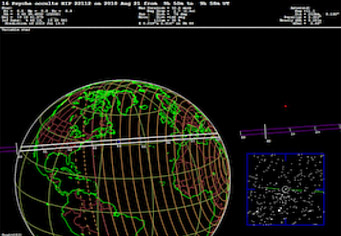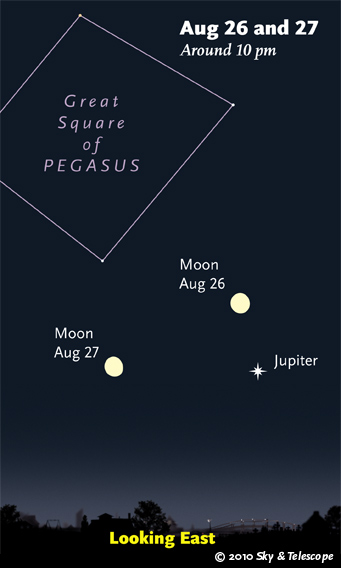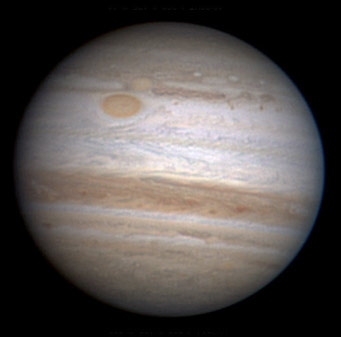FLASH! Another white-light flare has been videorecorded on Jupiter, by an amateur in Japan at 18:21:56 UT August 20th. And it's been confirmed from at least one other location. See our article.
Remember the similar event recorded on June 3rd? See Jupiter Takes Another Hit! and The Jupiter Meteor that Didn't Go Splash. Now that lots of people are videorecording Jupiter to make stacked-frame images, are visible impacts turning out to be fairly common?

The path of Psyche's star-shadow across Earth on the morning of August 21st.
Steve Preston
Friday, August 20
The asteroid-occultation community eagerly seeks accurate timings of such events, especially by video, which is more precise than eyeball timings. Read up on timing methods. If you get involved in this addictive pursuit, join the busy discussion at the occultation Yahoo Group.
Saturday, August 21
Sunday, August 22
Monday, August 23
Tuesday, August 24
Wednesday, August 25

Although they look close together, Jupiter is 1,500 times farther from us than the Moon is when they pass on the 26th and 27th.
Sky & Telescope diagram
Thursday, August 26
Friday, August 27
Saturday, August 28
Want to become a better amateur astronomer? Learn your way around the constellations. They're the key to locating everything fainter and deeper to hunt with binoculars or a telescope.
For an easy-to-use constellation guide covering the whole evening sky, use the big monthly map in the center of each issue of Sky & Telescope, the essential magazine of astronomy. Or download our free Getting Started in Astronomy booklet (which only has bimonthly maps).
Sky Atlas 2000.0 (the color Deluxe Edition is shown here) plots 81,312 stars to magnitude 8.5. That includes most of the stars that you can see in a good finderscope, and typically one or two stars that will fall within a 50× telescope's field of view wherever you point. About 2,700 deep-sky objects to hunt are plotted among the stars.
Alan MacRobert
Once you get a telescope, to put it to good use you must have a detailed, large-scale sky atlas (set of charts). The standards are the Pocket Sky Atlas, which shows stars to magnitude 7.6; the larger Sky Atlas 2000.0 (stars to magnitude 8.5); and the even larger and deeper Uranometria 2000.0 (stars to magnitude 9.75). And read how to use your charts effectively.
You'll also want a good deep-sky guidebook, such as Sky Atlas 2000.0 Companion by Strong and Sinnott, or the more detailed and descriptive Night Sky Observer's Guide by Kepple and Sanner, or the classic if dated Burnham's Celestial Handbook.
Can a computerized telescope take their place? I don't think so — not for beginners, anyway, and especially not on mounts that are less than top-quality mechanically. As Terence Dickinson and Alan Dyer say in their Backyard Astronomer's Guide, "A full appreciation of the universe cannot come without developing the skills to find things in the sky and understanding how the sky works. This knowledge comes only by spending time under the stars with star maps in hand."
This Week's Planet Roundup
Mercury is hidden in the glare of the Sun.
Venus, though bright at magnitude –4.4, is getting low in the west-southwest during twilight. It sets by dark.
Mars, vastly dimmer at magnitude +1.5, is a little to Venus's upper right. Look also for similar Spica farther to Venus's upper left for most of the week. Saturn has moved far off to Venus's right or lower right. Bring binoculars for all three of these faint objects.

By August 13th, Jupiter's Oval BA (Red Spot Junior) had nearly caught up with the Great Red Spot and was about to pass it. Also note the ghostly tan and blue-gray signs of the broad South Equatorial Belt hidden under white clouds. These traces now include the outline of the Red Spot Hollow just below the spot. South is up.
Christopher Go took this stacked-video image at 18:03 UT Aug. 13, 2010.
Alan MacRobert
Jupiter (magnitude –2.8, in Pisces) rises in late twilight and is well up in the east-southeast before midnight. It's highest in the south around 2 or 3 a.m. daylight saving time — the brightest starlike point in the morning sky.
Jupiter's Great Red Spot is near System II longitude 150°. Assuming it stays there, here's a list to print out of all the Great Red Spot's predicted transit times for the rest of 2010.
FLASH! Another white-light flare has been videorecorded on Jupiter, by an amateur in Japan at 18:21:56 UT August 20th, and it's been confirmed from at least one other location. See our article.
Remember the similar event recorded on June 3rd? See Jupiter Takes Another Hit! and The Jupiter Meteor that Didn't Go Splash. Now that lots of people are videorecording Jupiter to make stacked-frame images, are visible impacts turning out to be fairly common?
Uranus (magnitude 5.8, in Pisces) is about 2° west of Jupiter. In a telescope Uranus is only 3.7 arcseconds wide, compared to Jupiter's unusually wide 48″.
Neptune (magnitude 7.8, at the Aquarius-Capricornus border) is up high by mid- to late evening. See our finder charts for Uranus and Neptune in 2010.
Pluto (magnitude 14, in northwestern Sagittarius) is highest in the south right after dusk, but the bright Moon interferes this week. (See our Pluto finder charts in the July Sky & Telescope, page 60.)
All descriptions that relate to your horizon or zenith — including the words up, down, right, and left — are written for the world's mid-northern latitudes. Descriptions that also depend on longitude (mainly Moon positions) are for North America. Eastern Daylight Time (EDT) equals Universal Time (also known as UT, UTC, or GMT) minus 4 hours.
To be sure to get the current Sky at a Glance, bookmark this URL:
http://SkyandTelescope.com/observing/ataglance?1=1
If pictures fail to load, refresh the page. If they still fail to load, change the 1 at the end of the URL to any other character and try again.
 0
0
Comments
You must be logged in to post a comment.